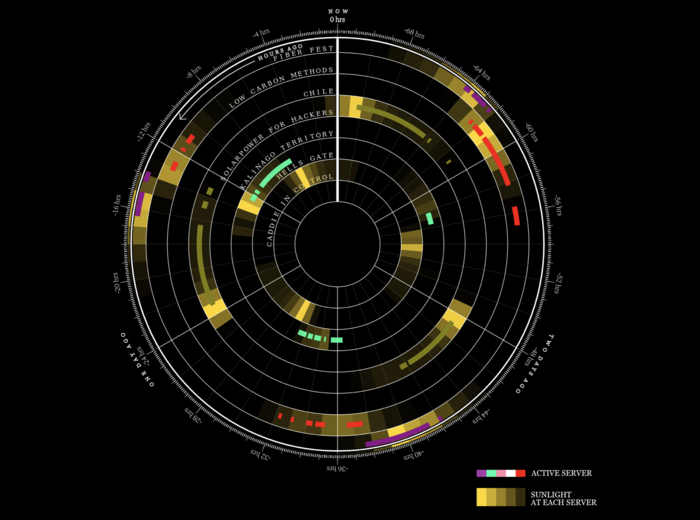While the internet can seem ethereal, with data being processed “on the cloud” the reality is it a materials and energy-intensive core infrastructure. It is estimated by the environmental organization Climate Care that servers are responsible for as much emissions as the global airline industry. This carbon intensity is only increasing with the advent of blockchain technology. One transaction of the cryptocurrency Ethereum is equivalent to the carbon impact of over 300,000 credit card transactions.
A group of researchers at the NYU Tandon School of Engineering have built a new network of servers intended to re-frame our understanding of the cloud, tying the impact of datacenters back to planet Earth.
The project, called Solar Protocol, is a network of servers that are directly tied to solar and energy storage. When the sun shines its brightest in a given region, that region’s servers are activated. The structure bucks the prevailing model of shifting data processing to the fastest, lowest-cost available processing capacity, to one that pays heed to the energy being used to power it.
The concept found initial support by the Eyebeam Rapid Response for a Better Digital Future and the Code for Science & Society digital infrastructure incubators. It won the Mozilla Creative Media Award, which supports internet health through open-source computing, inclusion, online privacy, and decentralization.
The decentralization of databases supported by the Mozilla award echoes a similar re-framing of how energy may be distributed in the future. In his book Freeing Energy, venture capitalist Bill Nussey explains how there are billion-dollar opportunities for innovation in an energy profile dominated by distributed renewable energy and battery energy storage.
In the Solar Protocol network light is shed on how the sun shapes daily behavior, seasonal activities, and decision-making. The website uses the availability of the sun as the core logic that powers its activation schedule.
“Solar Protocol is a great opportunity for us as artists to foreground issues of climate change and how technology is driving it,” said Tega Brain, an NYU professor and project lead. “The project has catalyzed conversations about AI and automation, as in-network user traffic is decided by solar energy. We are using intelligence from natural and dynamic versus a data-driven machine learning model… Why not think of planetary limits as intelligence? After all, they will shape the future of life on Earth whether we like it or not.”
The team explained Solar Protocol is not an alternative to the internet or something that is planned to be scaled, but rather an “open standard” and a model that can be replicated.
“How data is collected, managed, and trains AI systems has an impact on billions of lives. But that impact is often invisible. Creative Media Awards like Solar Protocol make the invisible visible,” said Kofi Yeboah, awards program officer at Mozilla.
This content is protected by copyright and may not be reused. If you want to cooperate with us and would like to reuse some of our content, please contact: editors@pv-magazine.com.









By submitting this form you agree to pv magazine using your data for the purposes of publishing your comment.
Your personal data will only be disclosed or otherwise transmitted to third parties for the purposes of spam filtering or if this is necessary for technical maintenance of the website. Any other transfer to third parties will not take place unless this is justified on the basis of applicable data protection regulations or if pv magazine is legally obliged to do so.
You may revoke this consent at any time with effect for the future, in which case your personal data will be deleted immediately. Otherwise, your data will be deleted if pv magazine has processed your request or the purpose of data storage is fulfilled.
Further information on data privacy can be found in our Data Protection Policy.